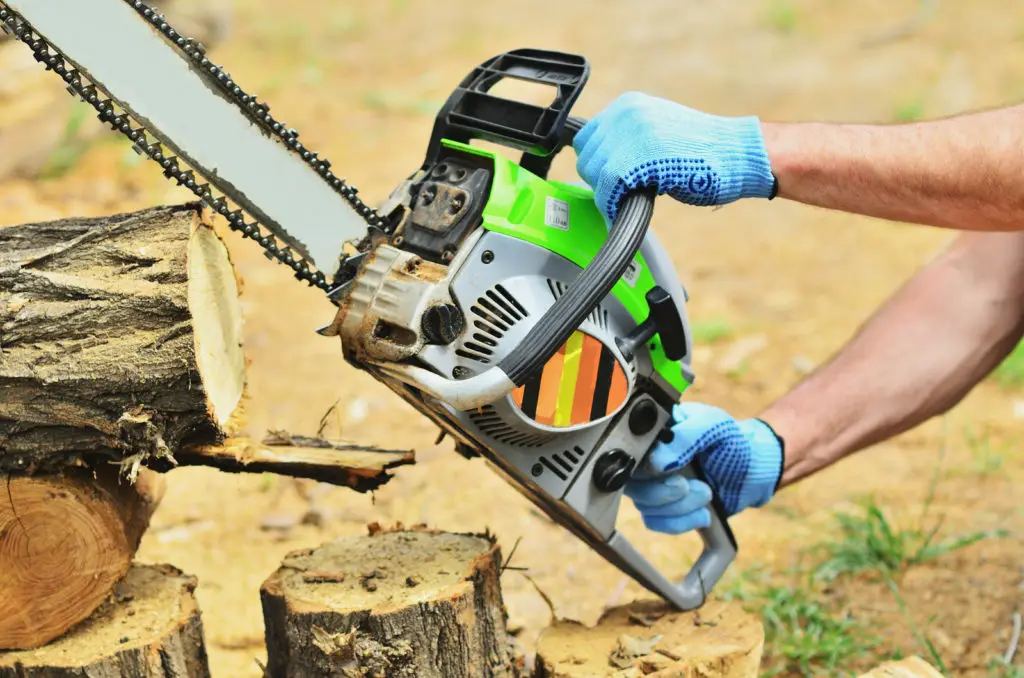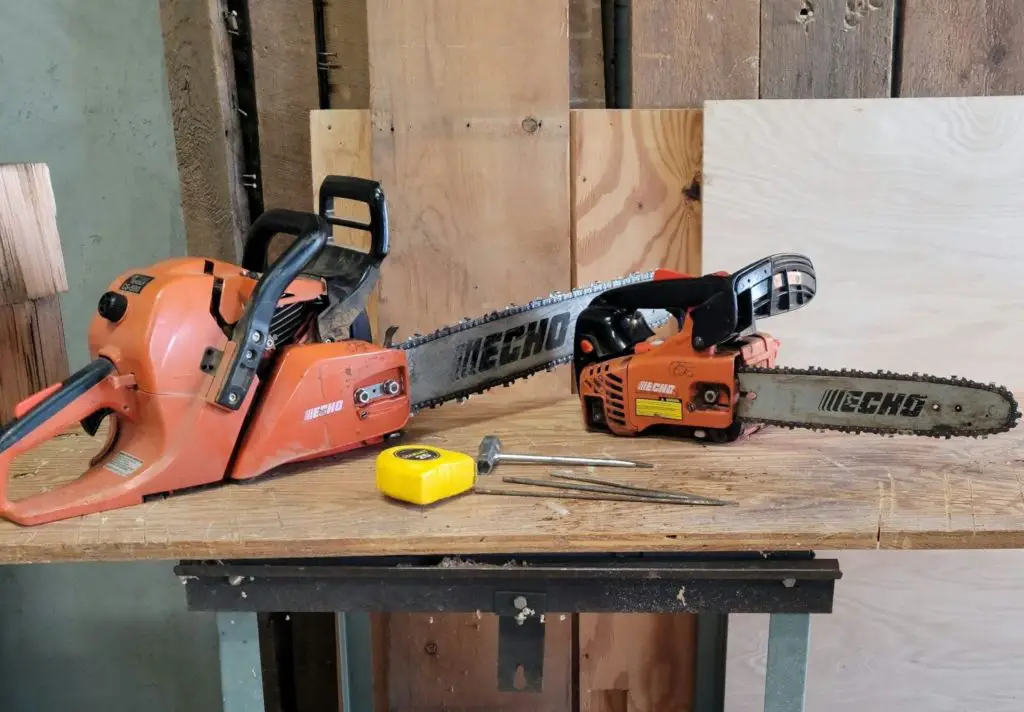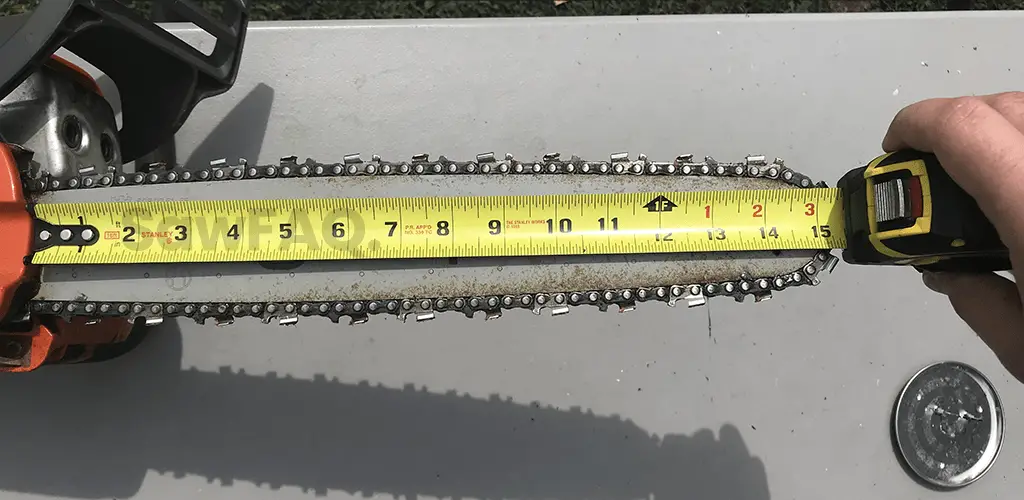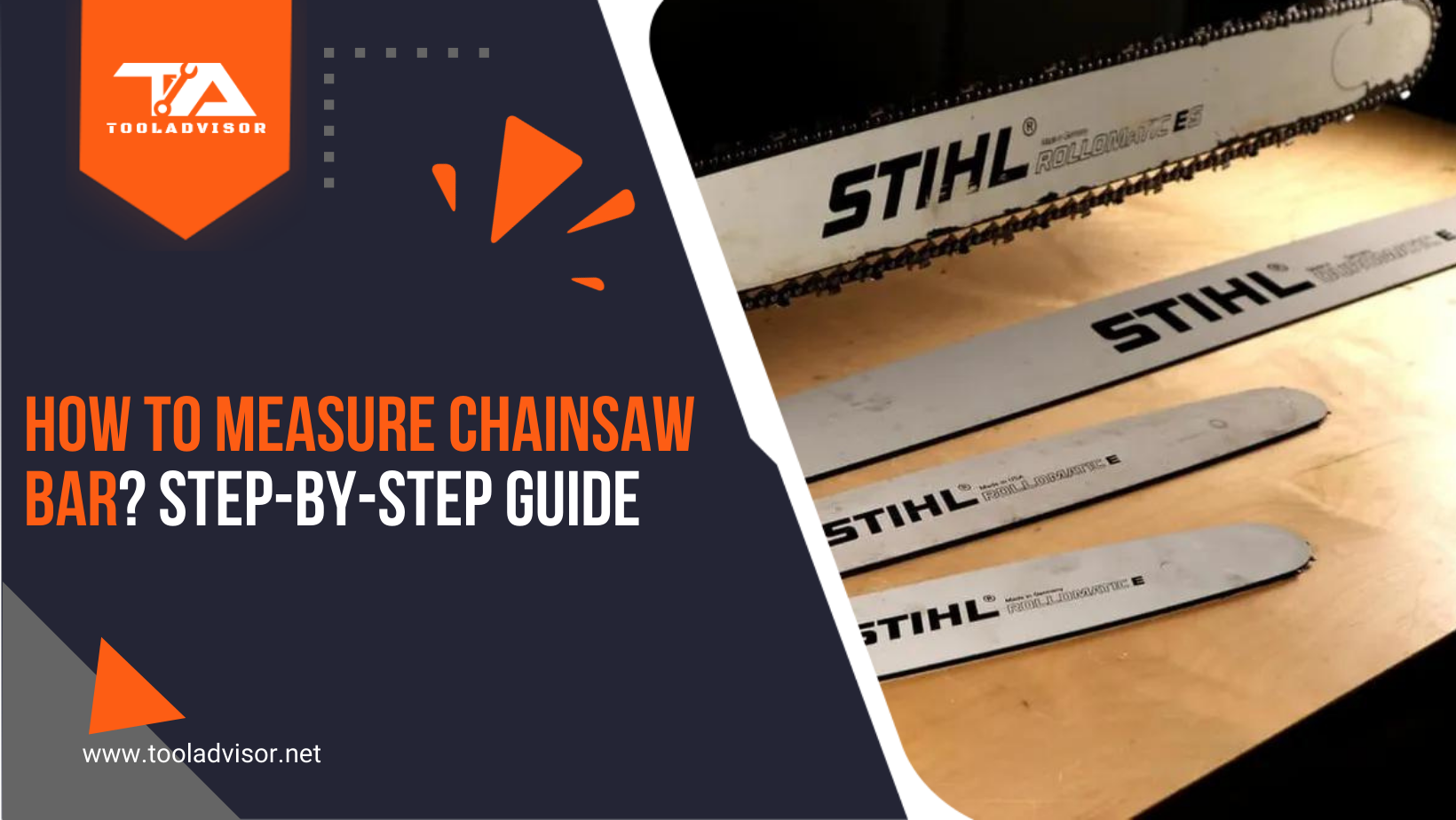Why is it important to measure your chainsaw bar before buying a new one?
Because chainsaws are designed for specific cutting diameters and shouldn’t be used with anything larger or smaller. You may get away with it, but the chain will wear out faster, and there is a risk of kickback. This can lead to injury or death.
How do you measure the chainsaw bar? The answer depends on what type of saw you own: electric, manual, or gas-powered (or some combination). There are two ways to measure a chainsaw bar. This guide will show you easy and accurate ways to measure chainsaw bars.
Keep reading for your chainsaw bar accurate measurement…
What Is the Bar on a Chainsaw?

The bar is the metal piece that the chain rides on. It’s essential to keep it sharp to make clean cuts.
Chainsaw Bars come in different sizes and are usually measured in inches or millimeters. The size of the bar will determine what type of wood you can cut.
Tools Needed for the Chainsaw Bar Measurement

- A tape measure or ruler
- Pencil or pen
- Caliper (for method 2)
- A longer piece of wood, so you can hold onto it while measuring the bar
If you’re looking for a replacement bar or chain that you’ve already used and loved, a fast calculator may be pretty beneficial.
But what if you’re looking for a different solution, such as a laminated bar that is more resistant to corrosion or a carbide-tipped chain that can withstand greater tasks?
You’ll be able to locate various replacements for essential elements of your saw, no matter how far from home (or a Wi-Fi connection) you are, once you know how to measure your bar and chain yourself.
Basic Terminologies We Need to Know Before Measuring Chainsaw Bar
Before we begin measuring saw chains, we need to understand some of the terms used.
1. Effective Cutting Length (Chainsaw blade length Or Called Length)
This is the length of the cutting edge on the bar. It’s measured from the tip of the tooth to the back of the tooth.
Start by measuring the blade’s length. Take a tape measure, start at the blade’s base, and stretch it out to the tip. Whatever number you get here, round it down to the nearest whole inch.
If, for example, your tool’s effective cutting length is 18 1/2 inches, you should round up to the nearest even number of feet – in this case, 20 (19 is an odd number; therefore, it wouldn’t be appropriate).
2. True Length
This is the measurement of the bar from the base to the tip.
To measure the true length of the bar, use a longer piece of wood as a guide. With the saw off, hold the guide against the bar’s base and run your finger along the top of the guide until you reach the tip.
Make a pencil line on the guide to mark that length.
Take the piece of wood and measure from the marking to the tip of your finger. That’s how you’ll know what your true length is.
To determine which bar will fit your saw, all you need to do is take a tape measure and measure from one side of the blade teeth to the other.
3. Pitch
This is the distance between the drive links on the chain. It’s usually measured in inches or millimeters.
4. Gauge
This is the thickness of the drive links on the chain. It’s usually measured in inches or millimeters.
5. Chain Number
This is the size of the chain. It’s usually measured in inches or millimeters.
Now that we know all of the basic terminologies let’s start measuring your chainsaw bar.
Also Read: What Chainsaw Size Do I Need? Complete Guide on Choosing Chainsaw Size
How Do You Measure a Chainsaw Bar for a New Chain?

Since there are different sizes for chainsaws, there may be various chains to choose from. In this section, we’ll tell you how to measure the chainsaw bar so you can purchase the right size of the chain.
Method 1 – Finding the Cutting and True Bar Lengths
- Unplug the spark plug wire – Remove the top cover from your chainsaw, then set it on a flat surface with the handle facing up. Remove the screws or bolts that secure the top cover to the chainsaw’s body and loosen them using a screwdriver or wrench. Locate a black wire plugging into a circular hole below the cover, then pull it out to disconnect the power.
- Take the blade’s cutting length as a guide, measuring from the tip to where it enters the body – At the end of a tape measure, put it inside the main chainsaw body. Extend the tape to the bar’s tip and take your measurement. Round down the figure to the nearest inch to discover how long your bar will cut. For example, the cutting length is 14 inches if your measurement is 13.58 inches (35 cm). The cutting length may also be called length, usable length, or effective length.
- Take the clutch cover off – Locate and remove the two nuts that secure the clutch cover on your chainsaw, then unscrew them with a wrench. Pull the cover off of the chainsaw straight away to expose the rest of the bar once you’ve removed the nuts. Before removing the clutch cover, move it forward to release it from the clutch. If your chainsaw has a brake, make sure it’s on before opening the clutch cover. Otherwise, putting it back on will be difficult.
- Measure the bar from end to end – To discover the real chainsaw bar length, start your tape measure at one end and stretch it to the tip on the other. To determine the true length of a chainsaw bar, round down to the nearest inch. If the measurement is 16 3⁄3 inches (41 cm), then the actual length of the bar is 16 inches (41 cm).
Method 2 – Measuring the Chain
- Remove the chain from the saw – Remove the old chain and clean off any debris from the gearbox housing. Use a wrench to loosen both nuts on the right side of your saw that retains the clutch cover in place. Take off the clutch cover to get at the rest of the chain. Remove the chain from the tensioner by pulling it toward you to release chain tension. Unloop the chain from around the clutch, where the bar connects to the saw and is known as a “clutch.”
- Measure the pitch – Start by laying the chain down on a flat surface so you can view the rivets, which are circular metal pieces that keep the chainlinks together. Start your tape measure at one edge on any rivet on the chain. Use a pair of wire cutters to snip the tape against the chain, following it as far as possible until you reach the end of the third rivet. To determine the pitch of the chain, divide the measurement by 2.
- Use a caliper to find the chain gauge – The measurement of the change is determined by the thickness of the drive links that fit in the chainsaw bar groove. Insert one of the drive links, which are thin metal pieces inside the chain, between the jaws or a caliper, and close them tightly to grip it firmly. To determine the gauge, check the measurement on your caliper.
- Count the number of chain links – The inside of the chain has pointed metal parts known as drive links. Mark one of the drive links with a dot on a flat surface. Count the number of drive links along the length of the chain, beginning at the one you marked. Continue to count down until you reach the one you marked and write it down.
Chainsaw Sizing Guide
Using the appropriate size chainsaw for the task makes cutting less difficult and dangerous.
The chain saw’s size varies widely depending on the brand and type of chainsaw used. The most frequent chain saw bar sizes are 12 to 20 inches, but they range in length up to 72 inches for specialists. The heavier the chainsaw, owing to the more extended bar.
For the task, choose a chainsaw with a two-inch longer chainsaw bar than the thickness of the material you’ll be cutting. Different types of jobs necessitate different chainsaw sizes:
- Gas-powered chainsaws range in size from 16 to 72 inches. Medium trees may be felled by 16 to 18-inch gas-powered chainsaws, while 20-inch or larger bar models are ideal for big trees or cutting firewood.
- Smaller electric chainsaws are often 14 to 16 inches in length. For felling small trees, use a 14-inch saw; use a 16-inch saw for medium trees.
- Batteries, however, tend to go dead quickly, and the weight of a cordless saw can be prohibitive. Battery-operated tree branch cutters are 16 to 18 inches long and ideal for felling medium trees.
- Although gas-powered models are available, most battery-operated chainsaws with a six- to nine-inch blade range fall into this category. The Milwaukee M12 Fuel Hatchet Six-Inch Pruning Saw is an example of a small battery-operated six- to nine-inch chainsaw. These are ideal for pruning little branches.
Chainsaw Sizing FAQs
How to measure the chain pitch?
The chain pitch is the distance between the links of a chain. Here’s how to measure it.
1. Using a ruler or measuring tape, measure the distance between three of your chain’s rivets.
2. Retake your measurement, but divide it by two. The chain pitch is the result of this calculation.
How to measure the driver links?
1. Simply count the links on your chain to determine the number of driver connections.
2. Identify the chain’s driver chain links. They’re little bumps on the inside of the chain that you may feel with your fingers if they’re small enough.
Will any bar fit a chainsaw?
Chainsaw bars are available in different configurations, including angle and height and various chainsaw chain pitches and gauges. They also differ depending on the intended mount geometry, which must match your saw’s and chain’s specifications. As a result, you can’t just throw any bar on any saw.
Final Words
This is a complete guide on measuring the chainsaw bar and its proper sizing.
Chainsaw bars come in various sizes, so it’s important to measure the bar before purchasing a new one. By knowing the chain’s pitch and the number of driver links, you can find a chainsaw bar that will be a perfect fit for your saw.
Always use the appropriate size chainsaw for the task at hand to make the job safer and more accessible.
If you have any questions, please leave a comment below.
We hope you found this guide helpful.

